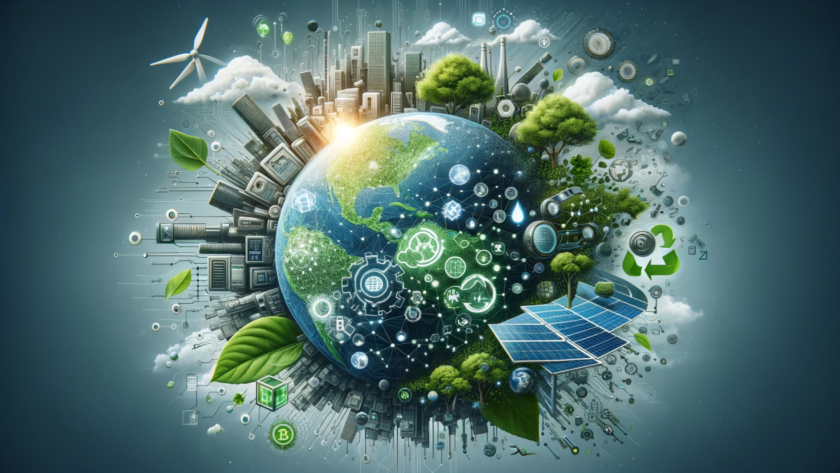Innovation is often seen as the engine that drives progress in societies and economies. From healthcare and education to technology and the environment, innovation holds the key to solving some of the world’s most pressing global challenges. Today’s world faces numerous complex problems, such as climate change, poverty, global health crises, and resource depletion. While these issues seem overwhelming, innovation in the form of new technologies, ideas, and approaches has the potential to provide solutions that are not only transformative but also sustainable.
This article explores how innovation can play a pivotal role in solving global challenges by examining its impact across various sectors, from health and agriculture to the environment and beyond. Through ingenuity and creative problem-solving, innovation can create pathways for a better future for all.
1. Innovation in Healthcare: Addressing Global Health Crises
Healthcare is one of the most important sectors where innovation can have an immediate and lasting impact. The global health landscape is burdened with issues such as pandemics, infectious diseases, lack of access to medical care, and increasing healthcare costs. These challenges demand innovative solutions that can improve access to healthcare, increase efficiency, and save lives.
Telemedicine and Remote Care
Telemedicine, an innovation driven by technology, has been particularly significant during the COVID-19 pandemic. With the use of video consultations, patients in remote or underserved areas can now access healthcare professionals from the comfort of their homes. This reduces the burden on healthcare systems, improves patient outcomes, and increases accessibility for those who may not have easy access to healthcare facilities. Through the use of mobile health apps, wearables, and diagnostic tools, telemedicine can further bridge the gap in health disparity across the globe.
Robotics in Surgery and Care
Another revolutionary innovation is the use of robotics in surgery and healthcare services. Surgical robots, such as the Da Vinci Surgical System, enable highly precise operations, reduce human error, and minimize recovery times. Robotics can also assist in elderly care, providing vital support for an aging global population. Robots can monitor health, administer medication, and assist with daily tasks, helping to improve the quality of life for elderly individuals while reducing the strain on human caregivers.
Artificial Intelligence in Diagnostics
Artificial intelligence (AI) is changing the way diseases are diagnosed. AI algorithms can analyze vast amounts of medical data to identify patterns and make predictions that would be nearly impossible for human doctors to detect. This technology is particularly useful in early-stage diagnosis of diseases like cancer, diabetes, and heart disease, providing doctors with more accurate insights and enabling faster treatment. As AI continues to evolve, its ability to assist in early detection and personalized medicine will improve, helping to reduce the burden of disease globally.
2. Innovation in Agriculture: Tackling Food Security
The global population is expected to exceed 9 billion by 2050, which will significantly increase the demand for food. Simultaneously, environmental challenges such as climate change, water scarcity, and land degradation are putting pressure on agriculture. Innovation in agriculture, often referred to as agri-tech, offers potential solutions to these problems, making food production more sustainable and efficient.
Precision Farming
Precision farming leverages technology like drones, sensors, and satellite imaging to gather data about soil health, moisture levels, and crop conditions. This data is analyzed to optimize farming practices, such as irrigation, pesticide use, and fertilization, reducing waste and improving crop yields. Farmers can make more informed decisions, increasing productivity while reducing the environmental impact of agriculture.
Vertical Farming
Vertical farming is an innovation that maximizes space by growing crops in stacked layers, often in controlled indoor environments. This method of farming uses less water, fewer pesticides, and can be done in urban areas, reducing the need for vast tracts of arable land. As the population grows, vertical farming could become a key solution to food security, particularly in densely populated cities and regions facing arable land shortages.
Robotic Harvesting
Robotic harvesting is another innovation gaining traction in agriculture. Robots designed to pick fruits and vegetables can work tirelessly, reducing the need for human labor while also ensuring precision. These robots can navigate fields, identify ripe produce, and harvest crops without damaging them. This innovation addresses the labor shortage in agriculture and increases efficiency, helping to meet the growing food demands of the global population.
3. Innovation in Clean Energy: Fighting Climate Change
Climate change is one of the most urgent global challenges facing the world today. Rising temperatures, unpredictable weather patterns, and environmental degradation threaten ecosystems, biodiversity, and human populations. Innovation in clean energy is crucial in addressing these challenges, as reducing our reliance on fossil fuels and promoting sustainable energy sources is key to mitigating climate change.
Renewable Energy Technologies
Solar, wind, and hydropower have become prominent renewable energy sources due to innovations in energy generation and storage technologies. Solar panels, for instance, have become more efficient and affordable over the years, making solar power a viable alternative to traditional energy sources. Similarly, wind turbines have grown larger and more efficient, generating more power with fewer resources. Advances in energy storage technologies, such as batteries, ensure that renewable energy can be stored and used when needed, overcoming the intermittency challenge associated with solar and wind power.
Green Hydrogen
Green hydrogen is another groundbreaking innovation in clean energy. Produced using renewable energy to electrolyze water, green hydrogen can serve as a clean fuel for industries such as shipping, steel production, and heavy transport. This form of hydrogen is seen as a critical tool in decarbonizing sectors that are difficult to electrify, offering a scalable and sustainable solution to the global energy crisis.
Carbon Capture and Storage (CCS)
Carbon capture and storage (CCS) technology allows carbon dioxide emissions to be captured from power plants and industrial sources and then stored underground or repurposed for use in other applications. This technology is vital in reducing global greenhouse gas emissions, particularly for industries where decarbonization is more challenging.
4. Innovation in Education: Bridging the Knowledge Gap
Education is a fundamental pillar in addressing global challenges. However, millions of people, especially in developing countries, still lack access to quality education. Innovation in education has the potential to bridge these gaps, making learning more accessible, inclusive, and effective.
EdTech and Online Learning Platforms
Online learning platforms such as Coursera, edX, and Khan Academy have revolutionized education by making high-quality learning materials available to anyone with an internet connection. These platforms provide access to courses from top universities and institutions, enabling students worldwide to access education at little or no cost. This innovation is particularly important in regions where access to traditional educational infrastructure is limited.
Artificial Intelligence in Personalized Learning
AI is also transforming education by enabling personalized learning experiences. Adaptive learning platforms use AI to tailor lessons to the individual needs and learning pace of students. This approach ensures that each learner can receive the support they need to succeed, improving educational outcomes globally.
Virtual and Augmented Reality (VR/AR)
Virtual and augmented reality technologies are making education more immersive and engaging. For example, VR can allow students to take virtual field trips to historical sites, explore complex scientific concepts through interactive simulations, or practice skills in a safe, virtual environment. This not only enhances the learning experience but also helps overcome barriers to access and provides new opportunities for students to learn in dynamic ways.
5. Innovation in Governance and Social Justice
Inequality, poverty, and lack of access to justice remain pervasive global challenges. Innovation is playing a role in improving governance, promoting social justice, and addressing inequality.
Blockchain for Transparency and Accountability
Blockchain technology, known for its use in cryptocurrencies, has the potential to improve governance by ensuring transparency and accountability in financial transactions, voting systems, and public records. Governments and organizations are exploring blockchain to prevent corruption, reduce fraud, and promote fair distribution of resources.
Fintech Solutions for Financial Inclusion
Financial technology (fintech) innovations have enabled millions of people worldwide to access banking services, even in regions where traditional banks are scarce. Mobile banking, digital payments, and micro-lending platforms have provided financial inclusion for people living in poverty, empowering them to access loans, save money, and start businesses.
7 FAQs on How Innovation Can Solve Global Challenges
1. How can innovation in healthcare improve global health outcomes?
Innovation in healthcare, such as telemedicine, robotics, and AI-based diagnostics, can increase access to quality care, reduce healthcare costs, and improve outcomes for patients around the world.
2. How can innovation help address food security issues?
Precision farming, vertical farming, and robotic harvesting are innovations that can improve agricultural productivity, reduce waste, and help ensure a stable food supply for a growing global population.
3. What role does clean energy innovation play in fighting climate change?
Innovation in renewable energy technologies, such as solar, wind, and green hydrogen, reduces reliance on fossil fuels, lowers greenhouse gas emissions, and promotes sustainable energy sources, helping to combat climate change.
4. Can innovation in education help bridge the knowledge gap?
Yes, innovations in EdTech, online learning, AI-driven personalized education, and VR/AR learning tools can make education more accessible and inclusive, particularly in underserved regions.
5. How can blockchain technology help improve governance?
Blockchain ensures transparency and accountability by making it difficult to alter or manipulate records, which can help prevent corruption, improve public trust, and promote fairness.
6. What is the role of robotics in solving global challenges?
Robotics can address challenges in healthcare, agriculture, disaster relief, and manufacturing by increasing efficiency, reducing labor costs, and providing solutions to tasks that are dangerous or difficult for humans.
7. How can innovation foster economic growth in developing countries?
Innovation can create new industries, improve productivity, increase access to resources, and enable entrepreneurship, all of which can drive economic development and reduce poverty in developing nations.
Conclusion
Innovation is essential to solving the world’s most pressing global challenges. Whether through breakthroughs in healthcare, advancements in clean energy, or new educational tools, innovation provides the solutions needed to address issues such as climate change, poverty, inequality, and food security. As technology continues to evolve, so too will the opportunities to improve the quality of life for millions around the world.
Key Takeaways
- Innovation in healthcare, including telemedicine, robotics, and AI, can improve access to care and reduce costs.
- In agriculture, precision farming, vertical farming, and robotics can help meet the global food demand sustainably.
- Clean energy innovations like solar, wind, and green hydrogen are vital in addressing climate change.
- Education innovations, including EdTech and personalized learning, can bridge the knowledge gap and improve global learning outcomes.
- Technologies like blockchain and fintech are improving governance and promoting social justice by ensuring transparency and access to financial services.
- As innovation continues to evolve, its role in solving global challenges will only become more critical.




